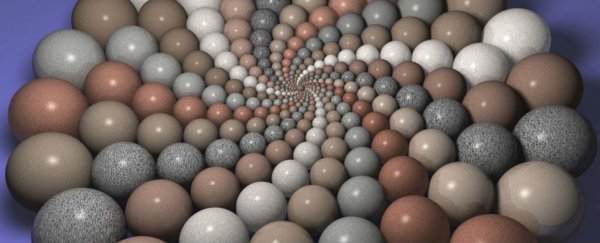Maybe it's your job to separate the signal from the noise in pictures sent by spacecraft a billion miles away. Or maybe you work at the grocer and you have to stack fruit as efficiently as possible so that no space is wasted. Or maybe you're a string theorist searching for hidden connections between fundamental constituents of the Universe.
Thanks to the interwoven quilt that is mathematics, each of these professions is related to stacking spheres. Some of those spheres are just in other dimensions.
In 3D, a sphere is the set of points that are all the same distance from a common centre – like a tennis ball or an orange. And if you've ever seen a pile of tennis balls, you know that there's always some empty space between the balls. If they're just poured out of a bag, about 36 percent of the resulting pile will be air.
The number drops to about 26 percent if you arrange the spheres very carefully - called the 26 percent method - but mathematicians have known since the beginning of the 20th century that there's no way to do better than that.
Mathematicians also play the packing game in higher dimensions, where spheres have the same definition, but the distances gain extra coordinates on top of the familiar three (x, y, and z, for example) that we're used to. And with more dimensions come more possible arrangements, so finding the arrangements that minimise the empty space has been challenging.
But a mathematician named Maryna Viazovska seems to have finally cracked the case, and for two particularly interesting cases.
She started off with an arrangement of eight-dimensional spheres called E8. E8 is a lot like a higher-dimensional version of the 26 percent method, except that in eight dimensions, there's enough space between the spheres that a new one can fit snugly between them.
And while string theorists don't use the spheres, they do use the structure of E8 as a key component of the way that the different dimensions of string theory relate to one another. String theory starts out with 26 dimensions, and has to fold them down into the three that we know, and E8 has all of the properties necessary to do that.
Mathematicians and physicists argued that this couldn't be a coincidence - they figured that the dimensions would act in the most efficient way possible, since any extra space would be harder to explain.
And it looks like they were right. Viazovska was able to show that E8 leaves no extra space anywhere; it's the most efficient way of stacking eight-dimensional spheres together.
But she didn't stop there. After she published her paper online at pre-print website arXiv.org, some other mathematicians who wanted solve the problem in 24 dimensions contacted her. "I felt like, 'I am already tired and I deserve some rest,'" Viazovska told Quanta Magazine. "But I tried still to be useful."
This time, the group was tackling an arrangement called the Leech lattice, stumbled upon by John Leech in the 1960s. Leech was trying to figure out ways to correct for errors or noise that would accumulate as signals traveled.
He found a way of arranging the data in 24 dimensions that made it very robust for tasks like transmitting pictures of Jupiter from half a billion miles away – which Voyagers 1 and 2 did a decade later using the Leech lattice.
The Leech lattice arranges information like someone might arrange spheres in those 24 dimensions, and mathematicians had again thought that seemed like the most efficient way to do it. Viazovska and her collaborators again proved the intuition correct, with a paper that came out just a week after the E8 paper did.
The two papers haven't been peer-reviewed yet, but there seems to be little doubt among mathematicians that they're right. And while the findings probably won't change very much about the computing and physics that make these two arrangements special, the methods used by Viazovska and her group could be extended to a lot of future proofs.
Maybe mathematicians will find stacked spheres in your job next.
